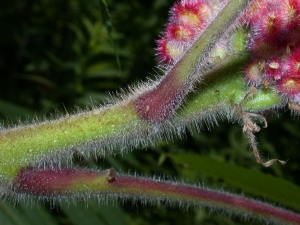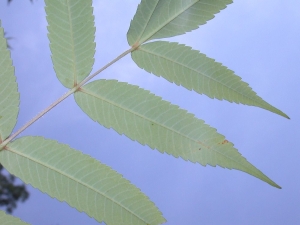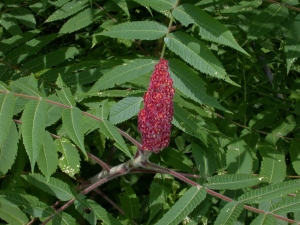Staghorn sumac,
Rhus typhina, is in the family Anacardiaceae. This family, the Cashew family, is rather large, with over eighty genera. We've heard of some of its other members- poison ivy (
Toxicodendron radicans), poison oak (
Toxicodendron pubescens) and poison sumac (
Toxicodendron vernix), but the subject of this month's article is not poisonous. It can be differentiated from another non-poisonous species in our area,
Rhus glabra, by the presence of fuzzy hairs on the former's twigs and petioles. The hairs on the stems and fruit of
R. typhina are so dense, brown, and fuzzy that they resemble the antlers of deer during their 'velvet stage', - hence the common name 'staghorn sumac'.
This is a large shrub, native to the Finger Lakes area, reaching to 30 feet in height. It branches repeatedly and has a poorly developed trunk. Each compound leaf consists of 12-30 leaflets. The individual leaflets have serrate margins, are similar in size, and up to 5 inches long. It is not difficult to find our subject this time of year for its large pinnately compound leaves, up to two feet long, turn brilliant red in the autumn. It likes dry, gravelly, soils and is often found growing along roadsides and waste areas.
The fruit of Rhus typhina occurs in dense, red, clusters which point skyward like flames. Each cluster consists of numerous (up to fifty) fuzzy, tightly packed drupes which mature in late summer.
Our local sumacs are rich in tannins. They were used in times past for tanning leather and today are often used as a mordant for fixing the colors of natural dyes when dyeing vegetable fibers such as cotton. The fruit can be crushed to make a refreshing lemonade and it can be brewed into sumac wine but care must be taken not to heat the syrup as the tannin will set and cause the wine to have a bitter taste. The astringent berries are relatively low in energy but, nonetheless, are a great source of food for local, overwintering, birds since they persist for months through our harsh winters. Our white-tailed deer also find them a source of nourishment, as one Cornell Cooperative Extension specialist reports in Woody Ornamental Plants Occasionally Severely Damaged by Deer.





